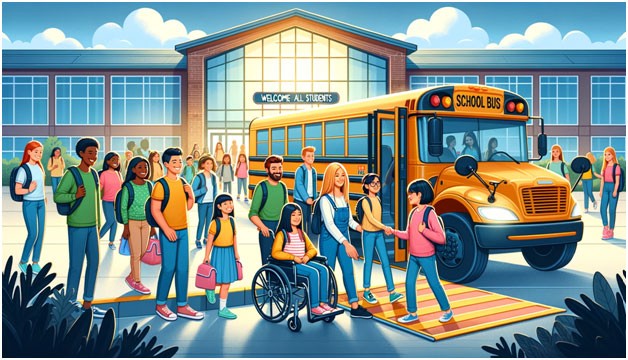
Image by Dall-E
The 7.3 million US students with a disability made up 15% of the school enrollment for the 2021-2022 academic year. Yet, parents of children with disabilities are less likely to enroll them in school. For millions of these children, who face a variety of physical, mental, and learning disabilities, transportation is still a huge obstacle to receiving an inclusive education.
When transportation for disabled students is unavailable, unreliable, or underserved, academic failures and social isolation for these children are never far behind. This increases pressure on often overwhelmed families to arrange transport. In many instances, homeschooling is their only option, creating a further financial and emotional burden for struggling parents.

Image by Dall-E
The Benefits of Inclusive Transportation
When inclusive transport is available and works smoothly, children with disabilities can flourish both academically and socially. This directly impacts their future and the future of their community. Disabled students who have seamless access to transport and complete school like their peers enjoy increased:
- Academic achievement
- Mood and social skills
- Life skills and independence
- Opportunities for further education and entering the job market
Societal benefits of inclusive transportation
When we build a truly inclusive world that embraces the lives and gifts of everyone we benefit as a society. By providing transport opportunities to children with physical, cognitive, or emotional disabilities, we allow them to reach their personal potential and foster an environment of compassion in the able bodied school community.
We have come a long way since the draconian ages of leaving disabled people behind. Some of our brightest scholars, such as Dr Stephen Hawking, dedicated their lives to the advancement of the world, which would not have been possible without inclusive policies and special assistance.
For those children suffering from a disability that will severely limit their options and health in life, giving them an opportunity to learn, socialize, and reach their own potential is a vital part of community care.
Current Transportation Challenges
Many families in the US are finding school transportation less available and reliable than in the past due to school bus driver shortages. Students who need special transportation for disabilities are posed with additional challenges due to both staff and equipment shortages.
In a recent article from the Washington Post, a mother from Washington DC explains the crippling daily uncertainty of never knowing whether her son’s school bus will arrive each morning.
The school consistently has issues providing buses fitted with the correct harness for her son’s disability. This hardware problem and many other staff and route related issues are making this family's daily life completely unpredictable.
As a child who loves to take the school bus and enjoys his enriching days at school, this lady’s son is becoming one of the forgotten children whose right to school transportation is not coming to fruition.
This is just one example of the thousands of families across America who feel their children are being forgotten

Image by Dall-E
Many schools are still not accessible
Despite regulations around discrimination and accessibility, many schools are still not completely physically accessible for disabled students. In many districts, accessibility is not likely to improve in the near future.
In 2020, a disappointing report showed that 70% of schools currently had no current plans to expand their accessibility for disabled children within the next three years. It also found that two out of three school districts still have some physical barriers to disabled students including steep ramps, narrow doorways, and complicated door handles.
IEP’s
To qualify for special transportation, the team in charge of a child’s IEP (Individualized Education Program) must agree that transport provisions are needed.
For many families, these IEP transport decisions have denied requests and restricted children’s access to special transportation, placing extra burden on families to provide their own transport, or consider homeschooling their children.
In many cases, school’s cite staffing shortages as reasons why special transportation cannot be expanded to serve more of the disabled population.
Funding and budget restrictions
As low funding for all school districts continues to be a problem, students facing challenges due to disabilities can find themselves with further disadvantages. Funding shortages can lead to a reduction in:
- Special needs bus drivers
- Compliant buses and equipment
- Support staff for disabled children
- Building of additional accessibility points
- Reliability of special transportation
Each of these restrictions affects ease of daily life for students who already face greater challenges to learning.
Trained bus driver retention
Many schools struggle to retain bus drivers for their regular routes. Drivers with the special skills to drive buses adapted for disabled children can be very difficult to replace. Many special bus routes for disabled children also require an attendant to support traveling students with their physical, emotional, and cognitive difficulties along the journey.
Staffing retention is a problem within many school bus districts. Due to the smaller number of children transported per bus on special transportation, driver shortages can cause disabled routes to be canceled, with active drivers needed to drive buses carrying large numbers of children.

Image by Dall-E
Legal Aspects
The Individuals with Disabilities Education Act (IDEA) requires that all students between the ages of 3 and 21 receive access to education and special education services where needed.
This law is a step in the right direction for the equal rights of disabled students, but the day to day realities of providing students with the transportation they require presents its own set of challenges. In order to comply with these new laws, schools must use their own judgment to decide which students qualify for transport services.
Compliance
To stay in compliance with this law for students who require special transportation attention, schools must not only consider provisions for transport to and from school with buses, but other special equipment to make transport around the school property possible. Unfortunately, for many schools, budgets have not allowed these improvements and disabled children still struggle with accessibility issues.
As children’s needs are currently decided by their IEP team at the school, the provisions required are often decided by the school themselves, leaving some parents angry and feeling excluded from services.
These provisions can include the use of:
- Special school bus transportation
- Ramps and lifts
- Support staff and specially trained drivers
- Buses adapted for modern wheelchair specs
National Disability Rights Organizations
Advocacy has been the biggest driving force in legal and community changes in accessibility and inclusivity. Organizations, individuals, and families have fought for decades by engaging their representatives, creating awareness, and holding businesses and schools accountable for their responsibilities with disability inclusion.
The National Disability Rights Network provides resources, advocacy, and support for people affected by, or advocating for disability rights in the US.
Partnering with advocacy groups for accessible transport in schools
By partnering with advocacy groups and disability rights organizations, schools and parents can access a greater network. With limited staff hours and a very limited budget, it is often tough for schools to fight for the rights of their students alone.
It is even tougher for families who can feel that their child's school is actively ignoring their disabled student’s needs. Engaging with local and national disability rights organizations, parents and school staff can find proactive help with their advocacy mission, and emotional support and understanding for the challenges they face.
Assessing Accessibility
Even when school districts provide plans for transport accessibility, many parents face a daily worry that buses will not turn up or be fully equipped to deal with their child’s disability. The disappointment these children face when they are unable to go to the classes they enjoy takes a toll over time, and for many students is their first experience of being regularly excluded. Schools often add to this exclusion by:
- Declining a provision of transport in a student's IEP
- Not recognizing a child's disability and providing accessibility
- Offering transport that is unreliable and creates unpredictability
- Sending buses that are ill equipped for the child
- Taking special needs bus drivers to cover regular school bus routes due to staff shortages

Image by Dall-E
Solutions and Policies
Balancing limited budgets for school transportation is a challenge for all administrative teams. In addition to calling for additional funding to meet the needs of disabled students, funding from within can be found when transportation directors can find alternative solutions.
In the Oakwood CUSD #76 district in Illinois, the transportation director was able to save a whopping $439,000 of the transportation budget by implementing Transfinder technology into their buses. By streamlining the routing experience for bus drivers, the district reduced the number of buses required to provide transport to all its students.
These in-house changes to the transportation department as a whole can open up much needed funds for schools to better care for the special requirements of students with disabilities.
To streamline current budgets and create more funds for special transportation, administrators must use a proactive approach to overhaul some budgets, policies, and staff retention incentives .
Emotional Narratives vs. Administrative Decision-Making
While creating school policies for inclusion and accessibility for disabled children, administrators must balance the difficult emotional conflicts of these decisions, with the realities of current budgets and culture.
Immediate change
Change is a process and administrators do not have the power to simply demand more funding or produce instant results. While long term solutions are being created, it is important for schools to do what they can in the present to help improve inclusive transportation problems where possible. Small changes that improve student lives go a long way to alleviating the emotional toil families face on a daily basis.
While the long term should always be full inclusion and support available for all disabled students, in the short term administrators need to assess where students are suffering the most from:
- Absenteeism due to lack of transport
- Extreme isolation and mental health consequences from lack of support
- Increased missing educational milestones for students with disabilities
To balance the current needs of disabled children and alleviate suffering in both the long and short term, administrators can consider:
- Better engagement with parents for IEP decisions and disagreements
- Further and ongoing communication with parents surrounding their child’s current and growing needs
- Investigating potential immediate budget savings to alleviate underfunded disabled transportation
- Fostering future engagement ideas and fundraising efforts with the school community
- Long term planning for school bus transportation as a whole
Better use of budgets
Administrative decision making must ensure compliance is being followed, and that budgets work accordingly. Administrators can begin to make room in their budgets for greater accessibility by:
- Investing in greater bus driver retention policies to reduce costly turnover
- Actively engaging with the families of disabled children to find where their greatest challenges lie, conserving budgets for the most pressing aspects of accessibility.
- Look to save on overall transportation costs by investing in technology based solutions such as Transfinder
- Engaging the school community as a whole to work tirelessly together to advocate for more funding at a government level
- Educate faculty, parents, and students on the importance of school-parent relationships
In Conclusion
Ensuring that students with disabilities continue to receive the services and specialized equipment they need to continue education relies upon adequate funding for each school district for their needs.
To push for greater access to disabled student transportation and accessibility in schools, it is important for faculty, parents, and wider community members to be proactive with their voice. Calling for greater funding opportunities at a local government level as well as pressing school administration on budget strategies can help to put a spotlight on these underfunded services.
Outside of the school setting, we can all help to ensure we are doing our part to serve the disabled population by ensuring we are mindful of inclusion and accessibility wherever possible in our businesses, work, and personal lives.
Additional Resources
- 4 inclusive school bus transportation strategies - This article offers insights into practical strategies for inclusive school bus transportation, particularly relevant to special education and IEP considerations.
- Accessible and inclusive transportation for youth with disabilities: exploring innovative solutions - Sally Lindsay's publication on PubMed provides an in-depth look at challenges and innovative solutions in providing accessible transportation for youth with disabilities.
- Supporting Independent Travel Through Skills Training - An article from the Institute on Community Integration Publications, focusing on travel training and instruction for individuals with disabilities, addressing barriers and benefits.



